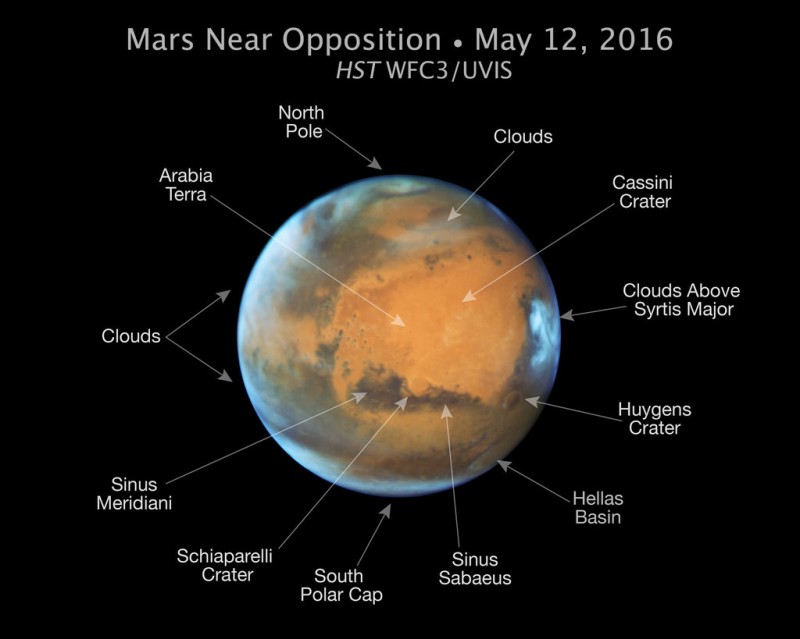 |
| Artist's concept of Mars Opposition. The distances between the sun, the planets, and the distant nebula are not to scale. |
Last week, Mercury stole the show. Now it's Mars' turn.
On Sunday morning, Mars, Earth and the sun will line up perfectly in the sky. This once-every-two-years event is called Mars opposition. That's because Mars and the sun will be on opposite sides of Earth.
Right now, Mars is about 48 million miles from us, coming ever closer until May 30, when the red planet passes within 47 million miles. That will be Mars' closest approach in 10 1/2 years. In 2018, Mars will get a lot chummier, passing within a mere 36 million miles.
The modern-day record of 34.6 million miles between Earth and Mars was set in 2003. That won't be surpassed until the year 2287, according to NASA.
At the other end of the scale, Earth and Mars can be as much as 249 million miles apart when they wind up on opposite sides of the sun every couple years.
Like all the planets in our solar system, Earth and Mars orbit the sun. But Earth is closer to the sun, and therefore races along its orbit more quickly. Earth makes two trips around the sun in about the same amount of time that Mars takes to make one trip. So sometimes the two planets are on opposite sides of the sun, very far apart, and other times, Earth catches up with its neighbor and passes relatively close to it.
During opposition, Mars and the sun are on directly opposite sides of Earth. From our perspective on our spinning world, Mars rises in the east just as the sun sets in the west. Then, after staying up in the sky the entire night, Mars sets in the west just as the sun rises in the east. Since Mars and the sun appear on opposite sides of the sky, we say that Mars is in "opposition." If Earth and Mars followed perfectly circular orbits, opposition would be as close as the two planets could get.
Of course, nothing about motion in space is quite that simple! Our orbits are actually elliptical (oval-shaped), and we travel a little closer to the sun at one end of our orbits than at the other end.
 |
| An illustration of the relative 'tilt' in the orbits of Earth and Mars |
When Can Opposition Occur?
Mars oppositions happen about every 26 months. Every 15 or 17 years, opposition occurs within a few weeks of Mars' perihelion (the point in its orbit when it is closest to the sun). This year, Mars opposition occurs on May 22, 2016.
An opposition can occur anywhere along Mars' orbit. When it happens while the red planet is closest to the sun (called "perihelic opposition"), Mars is particularly close to Earth. If Earth and Mars both had perfectly stable orbits, then each perihelic opposition would bring the two planets as close as they could be. That's almost the way it is.
But once again, nature throws in a few complications. Gravitational tugging by the other planets constantly changes the shape of our orbits a little bit. Giant Jupiter especially influences the orbit of Mars. Also, the orbits of Earth and Mars don't lie in quite the same plane. The paths the planets take around the sun are slightly tilted with respect to each other.
So, with all these added factors, some perihelic oppositions bring us closer together than others. The 2003 opposition was the closest approach in almost 60,000 years!
Mars' orbit is more elliptical than Earth's, so the difference between perihelion and aphelion is greater. Over the past centuries, Mars' orbit has been getting more and more elongated, carrying the planet even nearer to the sun at perihelion and even farther away at aphelion. So future perihelic oppositions will bring Earth and Mars even closer. But we'll still have bragging rights for awhile. Our 2003 record will stand until August 28, 2287!
 |
| On May 12, 2016, astronomers using NASA's Hubble Space Telescope captured this striking image of Mars, when the planet was 50 million miles from Earth. The photo reveals details as small as 20 miles to 30 miles across. This observation was made just a few days before Mars opposition on May 22, when the sun and Mars will be on exact opposite sides of Earth. Mars also will be 47.4 million miles from Earth. On May 30, Mars will be the closest it has been to Earth in 11 years, at a distance of 46.8 million miles. Mars is especially photogenic during opposition because it can be seen fully illuminated by the sun as viewed from Earth. |
 |
|
On May 12, 2016, astronomers using NASA's Hubble Space Telescope captured this striking image of Mars, when the planet was 50 million miles from Earth. Credit: NASA, ESA, the Hubble Heritage Team (STScI/AURA), J. Bell (ASU), and M. Wolff (Space Science Institute)
|
Read more: mars.nasa.gov